Environmental Science & Energy Consultant
Energy Advisor for Earth Day’s 20th Anniversary Committee
Operates GoingTrueGreen.com and EnergyHotwire.com
As men, women, and children, still struggle to get some respite from the massive storm we named Sandy, we hope and pray that everyone will be doing better before this Thanksgiving Day, over one year later.
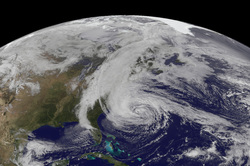 Super Storm Sandy from Earth's Orbit
Super Storm Sandy from Earth's Orbit Before we can identify proper solutions, data must be collected, evaluated, and realized. Let’s start with what is given to us and what we take away.
Disrespecting God’s Green Earth:
Our green planet provides us with free protection from storms along the coast. However for some reason, we humans, think we know better. Mother Nature gives us Salt Marshes, Primary and Secondary Sand Dunes held together by vegetation such as
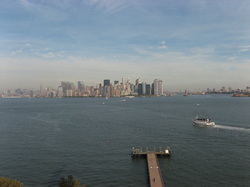 Photograph by Belenna Mesa
Photograph by Belenna Mesa 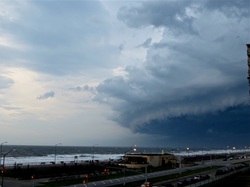 Photography by Tom Kerr
Photography by Tom Kerr To qualify as a hurricane, the new May 15, 2012 Saffir-Simpson Scale shows a maximum sustained wind between 74 and 95 miles per hour (mph) with a storm surge of 4 to 5 feet above normal to be a Category One storm. Even though Sandy had circular rotation with an eye, the storm didn’t meet all the qualifications to be a hurricane. The larger than normal size, the wind gusts up to 90 or 95 mph and larger storm surge still doesn’t qualify, but none of that makes any difference to all those people who lost their house, their memories, their lives.
We also received help from nature when Sandy passed over us. The radar image showed the cold front that pulled Superstorm Sandy over New Jersey’s shoreline, also absorbed the storm’s circular motion and the back half of the Sandy dissipated. Instead of morning bringing us another day of high winds and rain, we had cloud cover with light rain and brief gusts of wind.
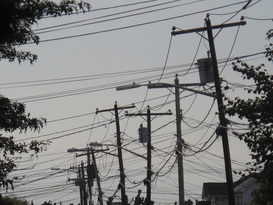 Power Lines Hanging Like Spaghetti
Power Lines Hanging Like Spaghetti How complacent have we become that we tolerate zero protection along the water and an infrastructure that is 70 years old? Water pours onto the city streets to flood tunnels, parking garages, and basements of apartment complexes. We have power lines hanging like spaghetti from wood poles installed by Ma Bell in 1940. We disobey Mother Nature’s rules and then we use Global Warming to place fault. Next we claim we are shocked, shocked to find so much destruction, but we still all want to collect our winnings. Yes, like the lines in a classic movie, the root to all this is money. Profits or paying share holders all comes first before improving our infrastructure to save lives in the future.
Sandy was a “wake up” call. If a category five with sustained wind around 156 mph and a 18 foot storm surge hit New Jersey, New York City or Long Island head on, the damage will be complete. Roof failures will be wide spread and building failures will be common. Water from the Atlantic ocean may even reach Hempstead Turnpike at some points of Long Island, New York. Power would be out for 100% of Long Islanders with today’s current system and about four to five months would go by before everyone had electric power again.
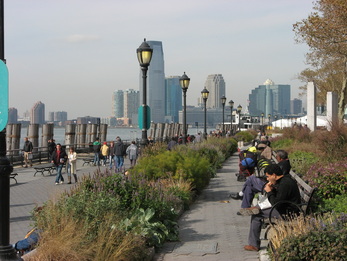 Area should be 10 ft. higher. - Why are the lights on?
Area should be 10 ft. higher. - Why are the lights on? New York City’s study and report for a stronger and more resilient coastal edge was well done. However, key areas of New York City need additional ten foot high naturally decorated berms with walkways and benches on top of the current 10 foot, 2 inch high edge. Since eighteen foot storm surges come with Category Five storms, twenty feet should be the minimum. Building along the edge of land is far cheaper than building a causeway with gates out in the harbor which would offer little protection. Think about all the water on the harbor side of those expensive gates. The 150 mph wind will be blowing all the water on both sides of those gates and all that water inside the harbor will still come up onto the streets of New York City.
Long Island, New York City and New Jersey need to start sealing wires underground over the next twenty years. This should be done systematically for the main roads as they are repaved or repaired. Then with priority businesses on the main roads not losing power, repair crews will be able to attend to downed neighborhood lines that much faster. Wood poles should be replaced with stronger poles like the ones used in Florida, where the lines can’t be placed underground due to the water table just a few feet below the surface. Since these types of upgrades have been spoken about for decades, but never ratified because of the claim that cost is unaffordable, a true comparison by an outside firm should be done against the costs to make twenty years of hurricane repairs.
I am presenting this request because of the understanding I received on sealing power lines underground when I worked for an electric utility. The following may stand true:
Burying power lines is too expensive for the power company when they have to use their own profits to do the work instead of profits going to share holders.
When a hurricane hits and significant repairs are needed, about every ten years in the Northeast, assistance and repair money comes from the government. Yes, us tax payers, thus it is cheaper to do repairs with tax payer’s dollars instead of burying power lines with their own profits. Thus, no more tax payer bailouts for repair costs. Power companies will have to establish a fund with their own profits for repairs. Immediately you will find twenty years of hurricane repairs is much more expensive than burying power lines along main roads. Also I am not opposed to the government reimbursing a utility for burying power lines equal to the repair amount provided for an average storm. This will be done only once after all the main roads that can host buried power lines have been completed.
We also have to better understand global warming and stop the assumptions from both camps. Both sides believe they have all the data, I believe we just opened the book and finished the introduction. Yes, there are risks. I choose to error on the side of caution. Nevertheless, realize that whatever we do to help our world from a serious global warming problem, that will not stop us from being hammered by hurricanes. They are part of our planet’s nature, so we cannot do one solution for global warming and ignore dealing with the infrastructure problems. We have to stop fighting over money and work together as one team. We must start protecting lives before the next storm. It is already too late for the victims of Sandy.
To see our video on this topic consider becoming a GoingTrueGreen member with GTG Membership Link at top of page.
Bill Lauto, at GoingTrueGreen.com
Environmental Scientist
International Sustainability and Energy Consultant
Contribute your comments!





















